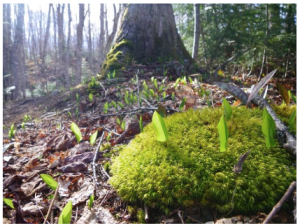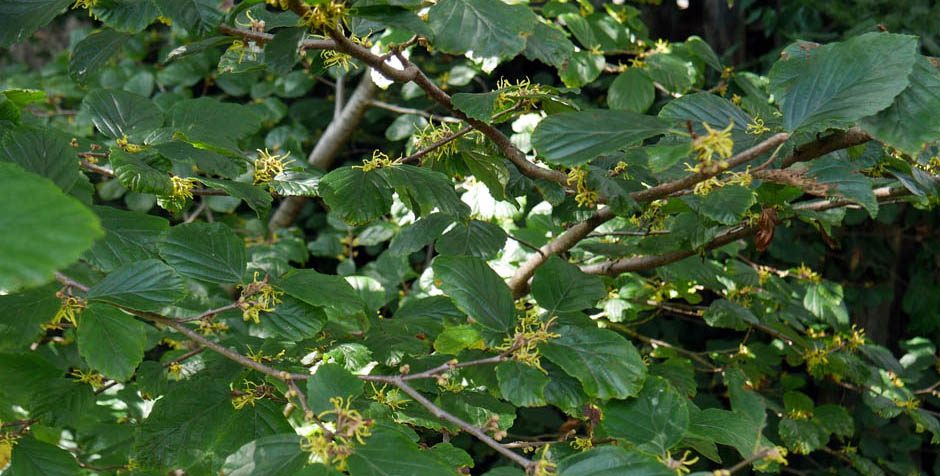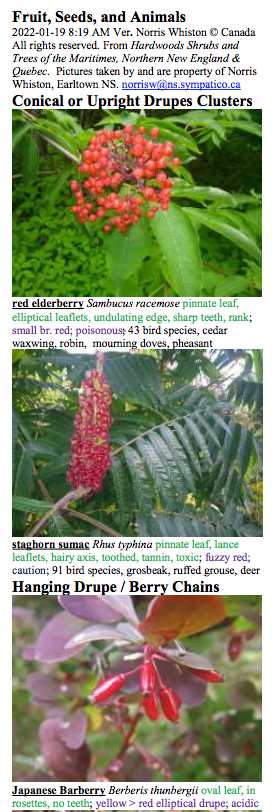Norris Whiston is a member of the NS Wild Flora Society. A retired science teacher, he was very involved in the creation of the Cobequid Eco -Trails Society. “Norris has written over 50 books and brought that passion to the landscapes of Colchester County, to the forests and to the pathways.” – view Hike Nova Scotia post for more about him.
One of Norris’s passions is compiling user-friendly guides to the local flora. He also has a fascination with the geological/geochemical/evolutionary history of the Earth, and likes to put it all together in historical guides. Norris generously shares some of these guides with all of us on this page.
New Jul 29, 2025: Mycorrhizae Evolution – Expanding Flora’s Range and Soil’s Carbon Storage“Due to mycorrhizae’s ongoing carbon soil storage, its processing of decaying biota, and its natural collaborators, Earth’s soil “contains twice the amount of carbon in all plants and Earth’s atmosphere combined.” Tragically, studies show current deforestation is causing high carbon losses in that soil for over 15 yrs and continuing losses for 30-40 yrs.”

Illustrative photo in Norris’s Adventures of Carbon and Nature. Caption reads: Dr. Ruth Wall Kimmerer, “The type of chlorophyll in their [the mosses’] leaves differs from their sun-loving counterparts, and is fine-tuned to absorb the wavelengths of light that filter through the forest canopy.” Filtered sunlight on a broom moss, Dicranum scoparium, beside a sugar maple, Acer saccharum, Rogart Trail, Earltown, Nova Scotia NM W
Jan 14, 2015:
Adventures of Carbon and Nature (Version updated Feb 6, 2025; PDF 5 MB) A 49 page referenced and illustrated document that cites or paraphrases extracts from credible articles and scientific papers to explain how carbon cycles though ecosystems and the atmosphere, and the practical implications. There are 4 sections*, each with subsections, all listed in the first 5 pages. It’s a great reference, with up-to-date literature citations (& I suspect Norris will be issuing updates), and just really interesting reading. Norris cites local examples, many with photos, of the features he covers. *A: Carbohydrate and biochemical creation, B: Carbon dispersal to soil ecosystems, covering of soil’s carbon, drought survival and fires, C: carbon emission from clearcuts, fragmented forests, wood products, biomass burning and their consequent carbon depletion from the soil, D: Atmospheric CO2, collectors, restoration and world effects from forestry.
New: Dec 9, 2024:
A Tale of Nature’s Collaboration – Mycorrhizal Connections and Evolution.
Norris’s “One-Pager” on the historical (geological) timeline for evolution of MycorrhizaeWhiston. Mycorrhizal Connections and Evolution
NEW May 4, 2024: Cobequid Mountain Field Guide – Lichens, Mosses, Club Mosses & Ferns
Norris assembled this document for participants in a Sandy Lake Forest Walk on Apr 27, 2024. 18 pages, it includes 68 colour photos & notes for the more common species.
Nov 22, 2023
Norris has provided a second document on the Keeling-Curve which provides some further context, another approach to explaining it which is complementary to the earlier document. It provides a timeline description of some of Earth’s glacial (ice ages) and interglacial stages (warm ages) seen in the Keeling chart. View
Whiston. Keeling Curve II – CO2 Levels in Context
NEW (Sep 28, 2023): The Keeling Curve and Nature’s Necessary Roles
A one-pager showing scientifically how nature affects Earth’s temperatures, and where we are today as a result of human nature to date, why we need to change. Says Norris: “It was created perhaps two month ago after a very well educated woman indicated to me that her husband was one of the climate deniers. I thought about how obvious the ominous situation was shown by one graph at the Keeling Curve site. I decided to create a page with that on it. My third paragraph is about nature. Nature was so important to how humans got their turn to inhabit the Earth and will be crucial to fixing things up somewhat. The most important graph I have placed at the end and I have limited it to one page.”
NEW (Aug 19, 2023): Whiston. 416,000-Year-Ago Glance at Greenland and its Natural World
View Post, Aug 20, 2023 for an introduction
Norris Whiston’s Flower Clusters & Ecology of Common Nova Scotia Trees and Shrubs (2022-08-06)
In this 4 page, colour photo guide, photos of 48 common NS trees and shrubs are organized by the shape/type of flower cluster (inflorescence). In the text, information is provided in note form for Common Name, Scientific Name, Flower Colour, Leaves (description), Defence (types of chemicals), Fungi (Arbuscular Mycorrhizal Fungi. Ericoid, Ectomycorrhizae Fungi), Site (Habitat),
Bloom (season or month of flowering). Besides helping us to recognize some common Nova Scotia shrubs and trees by their flowers and leaves, it offers tantalizing insights into the ecology of these 48 species. May be downloaded for individual use.
Norris Whiston’s Fruit, Seeds, and Animals (2022-05-02; PDF, 1.4 MB)
A 4 page document, 3 columns with 4 items per column, each illustrated with a colour photo by Norris and divided into categories (e.g., Conical or Upright Drupes Clusters, Hanging Drupe / Berry Chains) to facilitate quick ID. The text provides info on the use of fruits and seeds by animals. May be downloaded for individual use.
Norris Whiston’s Index & Keys for Trees & Shrubs of the Maritimes by Todd Boland (2012) (PDF, <1 MB)
Norris has prepared a detailed index and a variety of keys to aid in use of Todd Boland’s illustrated guide to over 230 native and introduced species of trees and shrubs in the Maritimes. (View Review of Trees & Shrubs of the Maritimes) Norris suggests attaching the 6 pages to the inside of the front cover. The index provides a quick reference to distinguishing different species within a taxon, e.g., under “hawthorne” he cites: hawthorn: 132 (6 or 8 lobes with large teeth); English hawthorn 134 (3-7 deep lobes); heather: woolly 40 (yellow); Scottish 41; pine barren golden 34;. His keys group species by Leaf Types, Flower Types, Seeds, Fragrance, Fall Colours, Bark and Twigs. NS Wild Flower folk who gave it a test-run found it very user-friendly.
Hardwood, Shrubs, and Nature’s Dynamics of the Maritimes and Northern New England (June 25, 2020 Version; PDF, 12 MB)
32 page well illustrated document. Pages 1-22 highlight diagnostic features of common hardwood and shrubs. Pages 22 ff are on “Nature’s Dynamics”.
May be downloaded for individual use.
| Some further comments by Norris about bark ID and bark – Norris’s “Bark Guide” is in the first 8 pages of the doc above (Hardwood, Shrubs, and Nature’s Dynamics of the Maritimes and Northern New England):
One part of identifying bark is to consider certain trees, like the green-barked aspens, use bark to convert more CO2 and H2O to carbos and oxygen. IDing most bark requires understanding each tree’s need to respire, to protect its internal moisture, and to prevent predators access to internal parts. One needs to understand each tree’s particular defense to pathogens and predators (sabinene, betulin, cyanide, salicin, tannin, thicker bark, etc.), and each tree’s version of how it expands its girth, utilizing old bark or disposing of it. Our own skin expands and flakes as we get larger and wrinkles in places where we get smaller. Dust mites are grateful for our disposed of flakes. The Plane tree flakes off big chunks of pollution-filled bark, leaving beautiful abstract patches. The plane group is one of Earth’s earlier trees and is now becoming more necessary as air pollution expands. There are some in Spring Garden Park in Halifax, at Alumni Gardens in Truro, but it is also planted along urban streets such as in Halifax’s south end. For most of a beech’s life and expansion, it dusts old bark off like humans do their skin. Most birches, mountain ash, and older cherries peel off old bark in a variety of amounts. The birch’s old skin and old dead trees fall and layer on the ground where on the oldest free nitrogen-fixing bacteria will live and so help out the community with its nitrogen needs. Other tree barks stretch until the bark cracks into either scales or strips. For some species one can see those stretch marks. The bark then seals old layers with resins etc. and bark gets harder for herbivores to eat through or more horrible tasting. Hard to chew or yucky tasting! Sounds like my meals. Resorting Michael Wojtech’s book via the types, widen my process of understanding ecosystems. Used were Wojtech’s trees that corresponded to the Northern New England and the Maritime forests, and, cut out, were those of southern New England. Reshuffling trees by their common idiosyncrasies exposed the betulin, cyanide, salicin, and tannin’s grouping traits. Seeing barks with similar barks beside each other, also makes it more obvious as to how they are different. The bark guide is in the first 8 pages of Trees and Shrubs of the Maritimes, but I’ve thought more about the ecosystem thing since writing it. In the guide, above the barks, there is placed a confirming leaf ID. Underneath are pictures of bark first in a younger stage or nearer the top of an older tree. A walk around a town or city would show up most of these traits and trees. In the end it is fun to confirm the decision on the bark by looking at the leaves on the tree or on the ground nearby. Those with lots of tannin, like the oak, its leaves decompose slowly and give one a longer existing confirming ID. – NW, May 4, 2022 |
A Tale of Nature’s Collaboration – 40 Years of Simard’s Scientific Research –
The Wood-Wide Web (Nov 1, 2022; 2 MB)
“As Dr. Simard has said life needed Mother Trees” comments Norris about his notes from his detailed reading of Finding the Mother Tree by Suzanne Simard (Canada: Allen Lane 2021. 350 pp). The document includes Appendices with notes and explanations on Fungal Types, Mycorrhizal Fungi, Nitrogen-fixing Bacteria and their Hosts, Plants’ and Lichen’s Defense Constituents.


